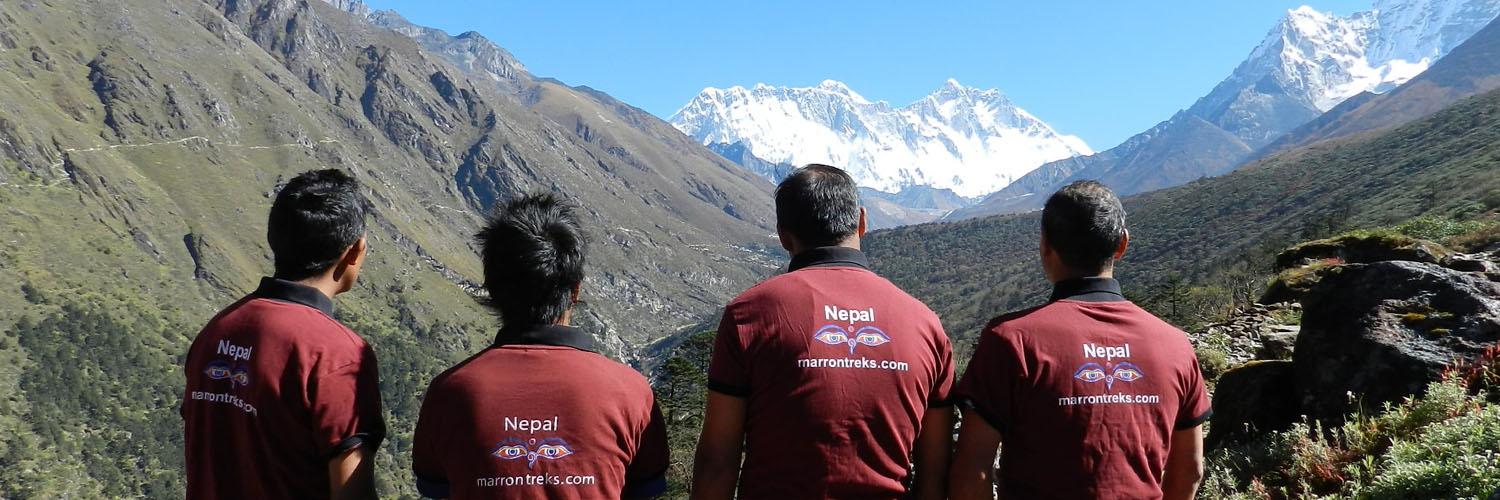Is a trekking guide necessary? Or may I trek in Nepal by myself? This is probably a question that you may ask yourself while you are planning a trek in the mountains of Nepal. Nepal's majestic Himalayas attract adventurous souls from all around, but navigating these awe-inspiring mountains requires more than just a good pair of boots. A guided trek offers several benefits over a solo trek, regardless of your goals—be it preparing for a strenuous and adventurous trek or a lesser-known moderate trek in the Himalayas. Let’s highlight the benefits of a trekking guide in Nepal below:
Safety First
Trekking in Nepal involves several obstacles and challenges, which can range from rugged terrain to unpredictable weather conditions, and potential altitude sickness, which can turn a dream trip into something else. An experienced and trained guide possesses the knowledge to navigate safely, identify hazards, and respond to emergencies. They are familiar with the areas you are trekking in much better and can react immediately to any emergencies that may arise during the trek, like illness, injuries, or altitude sickness. One should follow the guide’s instructions promptly, like sticking with your trek group and not walking separately on the trail, drinking enough water to stay hydrated to avoid altitude sickness, respecting the local culture.
Local knowledge
Trekking guides in Nepal have extensive knowledge of the local terrain, culture, and customs. They can provide valuable insights and information that you wouldn't be able to get on your own. These include detailed information on the culture and traditions of the places you visit along the trail. They know secret viewpoints, secluded campsites with spectacular panoramas, and alternative routes to avoid crowds or tackle challenging sections with the best approach. They can identify potential hazards like rockfalls, avalanches, or treacherous river crossings, keeping you safe and informed. Their many years of experience allow them to predict weather patterns, adjust itineraries to avoid potential risks, and ensure proper gear recommendations for a trouble-free holiday.
Cultural Bridge
Guides bridge the language gap, translating conversations with locals, helping you interact meaningfully with the locals and learn more about the local culture and tradition. They inform you about the local etiquette and customs, like the proper dress codes for visiting monasteries, respecting cultural practices during festivals, and ensuring you have the best information about the locals in the high Himalayas. Guides have a good connection with local teahouses and mountain lodges, offering a more authentic experience and the best hospitality.
Discover the Himalayas
They will help you spot the mighty peaks as they unfold as you trek along the trail, letting you witness the highest mountains in the world. They share captivating stories about the region's history, local legends, and myths associated with specific landmarks, enriching your understanding of the landscape. They explain the cultural significance of religious sites, prayer flags, and traditional practices you encounter along the trail, providing a deeper understanding of the region you are trekking.
Support and motivation
Trekking in the Nepalese Himalayas can be physically and mentally demanding. A guide can provide emotional support and motivation when you're feeling tired or discouraged, helping you push through difficult moments. Guides anticipate and solve unexpected issues, from gear malfunctions to minor illnesses. They can provide first aid and basic medical care, ensuring a smooth and worry-free trek. Trekking guides become your companions on the journey. Their enthusiasm and genuine hospitality can create a lasting bond and a lifetime friendship.
Emergency assistance
In cases of emergencies such as illness, injuries, or altitude sickness, a guide can provide immediate assistance and contact rescue services if necessary. Their knowledge of the local area and quick communication with the office can be crucial in getting help quickly. Trek guides are in constant contact with their office and immediately inform and act on any potential risk to the clients due to unforeseen illness/injury or altitude sickness, and assistance in rescue and immediate medical attention.
Guides in Nepal
In addition to trek guides, in Nepal, there are other travel guides such as city guides, peak climbing guides, wildlife safari guides, rafting guides, paragliding guides/instructors, and mountain biking guides. Among these are guides with varying specializations and works in their respective fields. Whatever the activities you want to undertake, an excellent guide should be enthusiastic about their work and make every traveler feel comfortable and meet the client’s needs.
Role of a Guide
Trekking guides should go beyond just getting you from point A to point B but to transform your journey into an enriching and engaging experience, according to Mr. Ram Kumar Adhikhari, a Director at Marron Treks. Sure, they handle the logistics like permits, transport, accommodation, and meals. But more importantly, they should be experts on the regions you explore with safety as their top priority, and they should have the knowledge to modify the trekking itinerary if required or tackle emergencies if needed.
|
Expert Navigator
Sure, a map and compass can get you pointed in the right direction, but a trekking guide brings a whole new level of navigational expertise to your Himalayan adventure. They go beyond traditional maps and compasses. They've hiked the mountain trails countless times, memorizing landmarks, hidden junctions, and alternative routes. This ensures you don't get lost and allows them to choose the most scenic or efficient path. To ensure that you get the most out of the breathtaking Himalayan scenery, they may customize your walk to fit your interests, pace, and weather.
Handling the logistics
Imagine you're in the heart of the Himalayas, surrounded by breathtaking scenery. But instead of worrying about permits, accommodation bookings, or lugging a heavy backpack, you're free to soak in the experience. That's the magic of having a trekking guide handle the logistical support on your Nepalese adventure. Your guide will check-in permits at the respective check-posts on the trail. They have established a good relationships with teahouses and lodges along the trekking routes and will book comfortable accommodations in advance, guaranteeing a warm bed and delicious meals after a long day on the trail. For those who prefer to travel light, your guide can arrange for porters to carry your baggage. This allows you to enjoy the trek at a more relaxed pace and avoid physical strain.
Responsible Travel
The Himalayas are a majestic natural treasure, but trekking in this fragile environment requires a commitment to responsible tourism. That's where trekking guides play a crucial role. They educate trekkers on the principles of Leave No Trace, minimizing waste by using reusable water bottles, packing out all trash, and practicing proper sanitation techniques. They lead trekkers on the right trails so as not to disrupt delicate vegetation and ecosystem .
Problem-Solvers
Even the most carefully planned trek can encounter unexpected situations. That's where a trekking guide's problem-solving skills become helpful. Whether it's a sudden rainstorm, a change in trail conditions, or a minor illness among trekkers, experienced guides can customize the itinerary. They'll find alternative routes, adjust schedules, and prioritize safety while still maximizing your trekking experience. Facing unexpected situations can be stressful, but a good guide remains calm and collected. Unforeseen obstacles like landslides or blocked paths can arise. Your guide's knowledge of the terrain allows them to find alternative routes, navigate around challenges, and ensure you reach your destination safely.
Guide as the Group Leader
Trekking in Nepal is a adventurous experience, but it's also a group activity. This is where a trekking guide goes beyond pathfinding and logistics, becoming a caretaker of the group. A good guide builds a sense of teamwork among trekkers. He encourages everyone to support each other, share resources when needed, and celebrate achievements together, creating a positive group atmosphere. Disagreements or minor personality clashes can arise on any group trip. Your guide acts as a neutral mediator, helping trekkers communicate effectively and resolve conflicts. Everyone has a different pace and experience level. A skilled guide will adjust the pace to accommodate slower trekkers, offer encouragement and support.
Supporting local economy
When trekking in the Himalayas, you are contributing to the well-being of the people who call this region home. It is because many trekking guides come from the very villages and regions you'll be exploring. When you are going with a local guide, your money goes directly into their pockets and their families' well-being. This provides a sustainable income source, uplifting local communities and economic development in remote areas.
Do I really need a guide to trek in Nepal?
If you're a seasoned hiker comfortable with navigation, high-altitude conditions, and independent travel, you might feel confident tackling some well-marked, lower-altitude treks without a guide, but still, the Himalayas are the highest locations on earth where many factors like weather conditions, risky trails, high mountain passes, remote trek areas, alternative routes, tricky and multiple trails can be obstacles. For even experienced trekkers, these things can pose a major threat if taken lightly and trekking solo in the Himalayas. Furthermore, trekking in Nepal regulations from April 2023 require all trekkers to have a trekking guide with a registered trekking agency in Nepal which sole purpose is to enhance safety and ensure responsible trekking practices. Looking into these matters, going along with an experienced trekking guide is highly recommended.
In conclusion, trekking guides in Nepal are more than just pathfinders. They are your gateway to a deeper understanding of the Himalayas, its people, and its cultural diversity. To put it simply, trekking guides in Nepal are cultural ambassadors, safety specialists, logisticians, and environmental guardians in addition to being leaders. Their commitment and knowledge uplifts the trekking experience, ensuring trekkers achieve their Himalayan dream exploring Nepal's spectacular Himalayan trails.
Author: Marron Treks
Date: 22nd July, 2024


